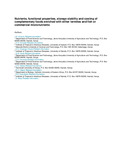Nutrients, functional properties, storage stability and costing of complementary foods enriched with either termites and fish or commercial micronutrients
Date
2015-01-11Author
Kinyuru, J.N.
Konyole, S.O.
Omolo, S.A. Onyango
Kenji, G.M
Onyango, C.A.
Owino, V.O.
Owuor, B.O
Estambale, B.B.
Roos, , N.
Metadata
Show full item recordAbstract
Application of edible insects in complementary food production has not been studied much. This study developed and evaluated complementary foods based on edible termites to combat child malnutrition in Kenya. Two complementary foods, Winfood Classic (W-C; containing termites and dagaa fish) and Winfood Lite (W-L; without termites and dagaa fish) were formulated and processed by extrusion cooking. Their nutrient content, functional properties, storage stability and cost of the foods were evaluated using standard methods. W-C contained significantly higher (P<0.001) levels of 423.6 kcal/100 g energy, 19.1 g/100 g protein, 12.3 g/100 g fat, 6.3 mg/100 g zinc than W-L which contained 407.2 kcal/100 g energy, 14.6 g/100 g protein, 9.0 g/100 g fat and 5.5 mg/100 g zinc. Iron content in W-C (12.2 mg/100 g) and W-L (12.5 mg/100 g) were not significantly different (P=0.37). The energy contribution from fats (26.1 E%) from W-C was within the recommend levels in complementary foods while energy from proteins (protein E%) was higher from the two foods (18.0 and 14.3 E%, respectively). Bulk density was significantly different (P=0.02) amongst W-C and W-L and within the recommended levels of ≤0.5 g/cm3 in complementary foods. The foods were shelf stable for 6 months of storage with neither pathogenic microorganisms nor aflatoxins reported. Peroxide value was below the limits (≤10 meq/kg) after 6 months of storage. Production cost of the foods was 3.21 and 2.23 US$/kg for W-C and W-L, respectively, with termites contributing 42.3% of the basic cost of production in W-C. The study confirms that termites and dagaa fish can be utilised in processing of affordable and safe complementary foods with adequate nutrient density.
URI
https://doi.org/10.3920/JIFF2014.0011https://www.wageningenacademic.com/doi/10.3920/JIFF2014.0011
http://r-library.mmust.ac.ke/123456789/1548
Collections
- Gold Collection [1026]

